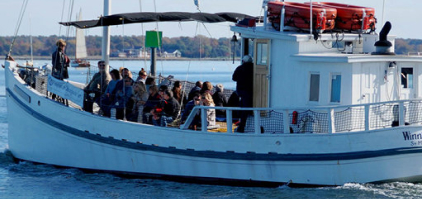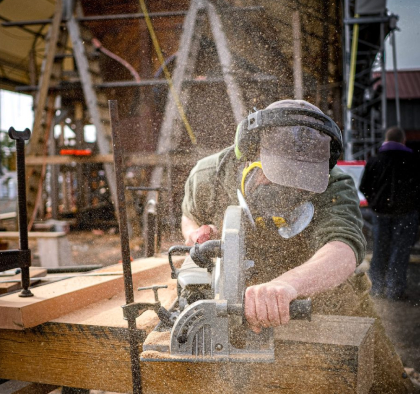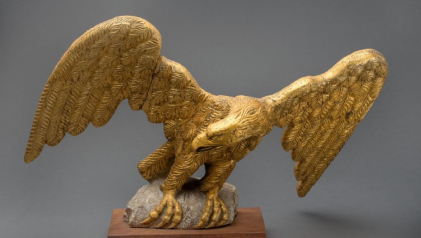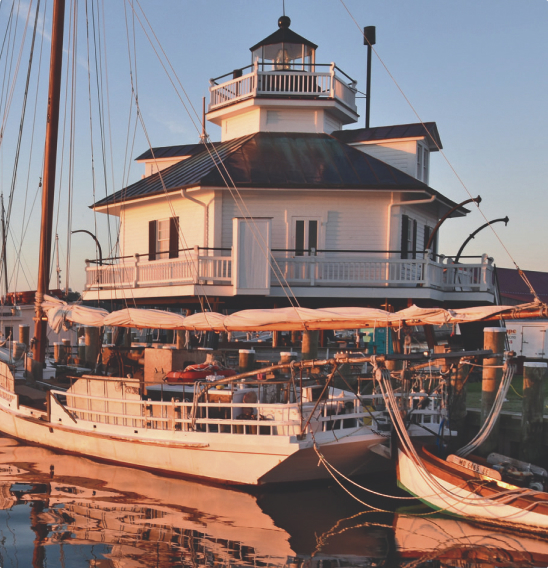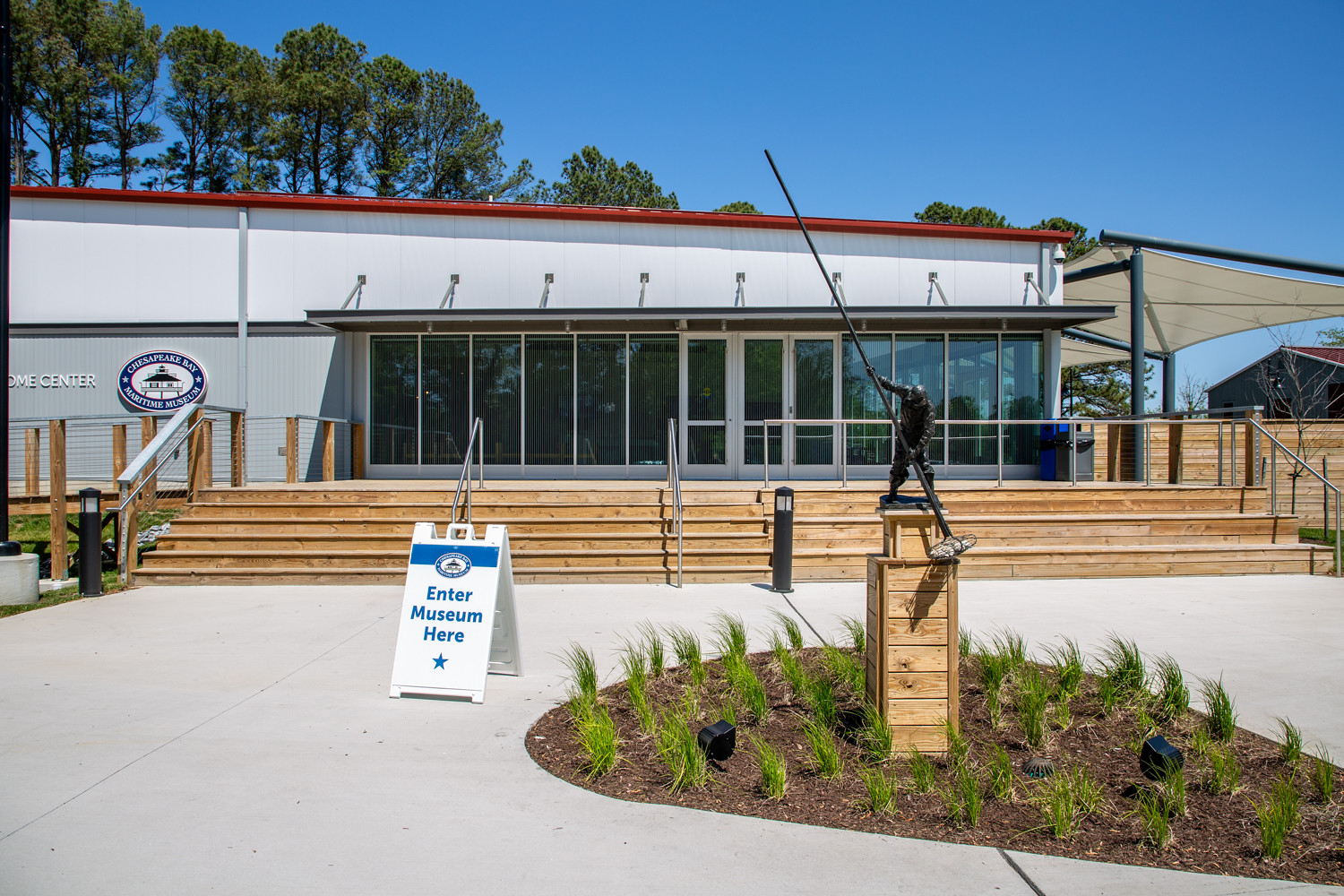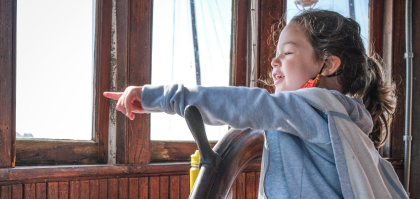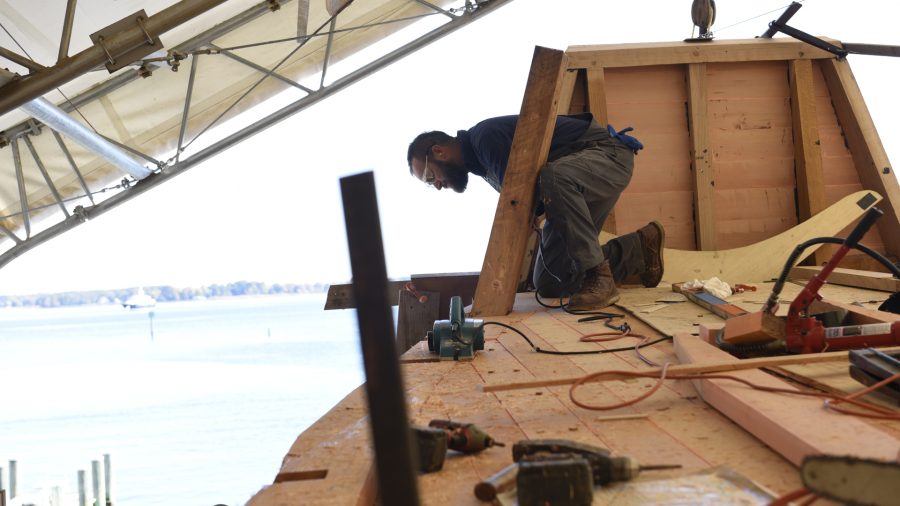The Chesapeake Bay shoreline was once home to scores of small shipyards where skilled shipwrights built and maintained hundreds of wooden vessels. These craftspeople not only supported the region’s commercial growth—they passed along skills that had been refined over hundreds of years. Because most of these yards have disappeared—and, along with them, the skills and techniques of the builders—there is a dearth of proficient boatbuilders today.
The Chesapeake Bay Maritime Museum’s working Shipyard both preserves and represents the tradition of a working waterfront. CBMM’s shipwrights and apprentices provide a tangible connection to the Chesapeake’s rich story of boatbuilding through:
- The preservation and maintenance of CBMM’s floating fleet of Chesapeake Bay vessels and its historic small boat collection
- Hands-on Shipyard education programs
- Construction, care, and preservation of the vessels of like-minded organizations and clients
Shipyard staff interact with CBMM guests, explaining their work and sharing the boats for which the Chesapeake Bay is known. Shipwrights and apprentices also demonstrate their skills at CBMM’s festivals and special events.
CURRENT PROJECTS
Just a few years ago, the buyboat now known as Choptank was Crow Brothers II and seemingly nearing its end on a mud bank in Knapps Narrows next to Tilghman Island. That’s when the team of Joe Robillard, Mike Avery, and Wes Abell stepped in to help, with a vision for what the 1938 buyboat with a long commercial history could be again and a plan to make it happen. Rebuilt locally with painstaking care over a period of years, Choptank has retained its historic charm while gleaming with modern style. Late last year, the boat made its way to CBMM for the completion of its renovation. The Shipyard is overseeing the final fit out, which involves building out the interior with cabins and heads for expedition-style overnight trips, outfitting it with modern safety equipment, and fabricating and installing a new rig. Later this spring, CBMM will initiate the review for Coast Guard certification, with inspections and stability testing, to be able to carry passengers. The plan after that process is completed is for it to stay at CBMM to allow for increased on-the-water programming, including overnight excursions.

Back in August, a group piled onto Winnie Estelle to escort Maryland Dove on its initial departure out of St. Michaels Harbor toward its new home at Historic St. Mary’s City. While brief, that cruise was a chance for some volunteer crew and staff to say goodbye to Winnie as well as part of the final week of the venerable boat’s ninth season at CBMM and 102nd year overall before a needed refit. Winnie was craned and drydocked last fall and will spend most of 2023 undergoing a significant refit. This spring, the CBMM Shipwrights have to lift the boat to pave the way for the removal, fabrication, and replacement of its structural timbers, including the keel, chines and many of the bottom boards. It’s not the first refit for Winnie Estelle. It had approximately 80% of its original wood replaced while being renovated by Roberto Smith in Belize in the mid-80s, but the keel is original. The new one will be made of white oak sourced from New York, and the CBMM team will try to re-use as much of the wood as possible while maintaining as much historical integrity as practically possible. This project is on the scale of previous refits performed on historic vessels Edna Lockwood and Rosie Parks.

PAST PROJECTS
Mr. Dickie, named after owner Grigg Mullen’s former neighbor growing up in Queen Anne’s County Dickie Whaley, was completed in Oct. 2023. The vessel is an homage to the 60-foot Mundy Point to bring the buyboat look to a scaled-down 36-foot design that features heart pine, white oak, Atlantic cedar and western red cedar. A retired engineering professor, Mullen started the process of building Mr. Dickie at his home in Virginia’s Shenandoah Valley, but when he decided he needed help, it was a natural fit to bring the project to CBMM. Mullen turned the build over to the CBMM team while continuing to source materials and pitch in whenever his time allowed. Mullen watched the buyboat progress toward his vision under the lead of Shipyard Foreman Jeff Reid, who enjoyed sharing the framing and lofting techniques that have been used for 100+ years with the latest generation of builders. For guests, it represented a rare look at the step-by-step process of a traditional Chesapeake build that encourages repeat visits to the Shipyard.
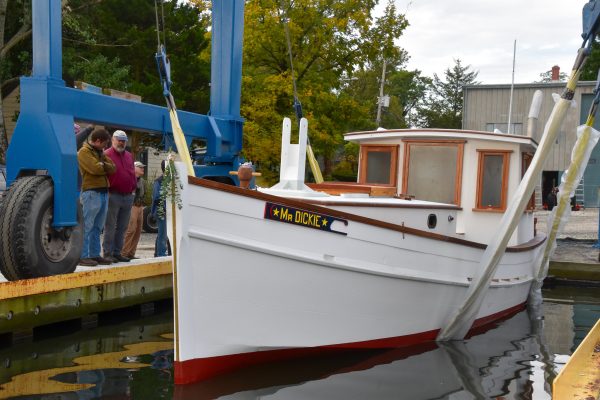
Mr. Dickie was launched into the Miles River in October 2023.
In 2018, it was announced that CBMM had been selected to build a brand-new Maryland Dove for Historic St. Mary’s City. A representation of the late-17th-century trading ship that accompanied the first European settlers to what is now Maryland, the ship is owned by the state and is operated and maintained by the Historic St. Mary’s City Commission. An earlier version of the ship, built in the 1970s by Cambridge’s Jim Richardson, was nearing the end of its useful life. Decades of new research meant that a new, more historically accurate representation of the original Maryland Dove could be designed.
Following that announcement, construction of the iconic ship became the central focus of CBMM’s working Shipyard. The three-year historic build, all done in full public view, saw the new ship move from concept to reality, culminating with Maryland Dove sailing to its homeport in Historic St. Mary’s City in August 2022. There, it serves as the organization’s floating ambassador, its flagship exhibition, and a key tool in its educational programming.
Log canoes are among the oldest staples on the waters of the Chesapeake, with origins that can be traced back centuries to the region’s Indigenous peoples. No longer built or used as working boats, these vessels perform as racing craft in the summer months. This Tilghman Island-style five-log canoe was built as a private commission from excess loblolly pine logs used in the historic restoration of Edna E. Lockwood. At 32.5 feet in length, Caroline is the first log canoe of its size to be built in decades.
Following a historic two-year restoration project, 1889 bugeye Edna E. Lockwood was relaunched into the Miles River during CBMM’s annual OysterFest in October 2018. Edna, queen of CBMM’s floating fleet, spent several years having her nine-log hull completely replaced by CBMM shipwrights and apprentices. All work was done in full public view in CBMM’s working Shipyard and in adherence to the Secretary of the Interior’s Standards for Historic Vessel Preservation. Shipwright apprentices working on the project were generously supported by the Seip Family Foundation and the RPM Foundation.
Built in 1889 by John B. Harrison on Tilghman Island for Daniel W. Haddaway, Edna E. Lockwood dredged for oysters through winter and carried freight such as lumber, grain, and produce after the dredging season ended. Edna worked faithfully for many owners, mainly out of Cambridge, Md., until 1967. In 1973, Edna was donated to CBMM by John R. Kimberly. Recognized as the last working oyster boat of its kind, Edna E. Lockwood was declared a National Historic Landmark in 1994.
Adapting the lines from an 1893 Robert D. Lambdin canoe in CBMM’s collection, CBMM shipwrights, apprentices, and volunteers began crafting this new sailing log canoe in the fall of 2014. The hull was constructed from three 26-foot local loblolly pine logs, with the canoe and its spars constructed in full public view. Bufflehead was the first log canoe to be built at CBMM since 1979.
CBMM’s 1955 skipjack Rosie Parks underwent a three-year restoration at CBMM from 2011–2013. All work was performed in full public view and with the help of apprentices and volunteers. Built by legendary Dorchester County boatbuilder Bronza Parks for his brother, Captain Orville Parks, Rosie once plied the Chesapeake dredging for oysters. The historic skipjack can now be seen dockside at CBMM or racing in the annual skipjack races near Deal Island and Cambridge.
SHIPYARD CAREER OPPORTUNITIES
CBMM’s Shipyard is a working exhibit of Chesapeake Bay wooden boatbuilding and restoration. It is open to the public seven days a week and is staffed by CBMM employees and volunteers. CBMM’s shipwrights and apprentices are a tangible connection to the Chesapeake’s rich story of boatbuilding. Shipwrights restore, build, and maintain traditional wooden vessels while allowing full public access to the process.
Interested in restoring, building, and maintaining traditional wooden vessels in CBMM’s Shipyard as a Shipwright or Shipwright Apprentice? Email hr@cbmm.org
FLOATING FLEET
CBMM maintains historic vessels the way they were intended to be used and seen—afloat on the water. They are representative of many of the vessels that were developed and used on the Chesapeake Bay. These rare survivors represent some of the last of their types. CBMM remains committed to maintaining them afloat and keeping them in operating or sailing condition.
LET’S BUILD YOU A BOAT!
Commission a vessel that reflects the Chesapeake Bay’s rich heritage of wooden boatbuilding. CBMM’s working Shipyard offers clients new wooden boat construction, complete boat restoration, and historic replica construction projects.
CBMM’s Shipyard has been building and restoring historic wooden boats and educating the public since 1965. CBMM’s wooden boatbuilders are masters of their craft and hold a deep appreciation and passion for traditional Chesapeake Bay workboats.
Our expertise in Chesapeake Bay boats derives from the skills and techniques handed down from the region’s early-19th-century boatbuilders. We have the knowledge to recommend solid timber and source-specific woods, and a collaborative build process to deliver high-quality work, vessel longevity and reduced maintenance.
Our custom builds are designed to fulfill your needs while integrating traditional wooden boatbuilding techniques with modern construction. Each build, restoration, and historic replica is meticulously researched for accuracy and incorporates appropriate materials for integrity.
The 25,000 square feet of dedicated Shipyard workspace includes a 100-ton railway, a 40-ton crane, a sawmill, and a full complement of stationary tools. Our highly skilled team specializes in carpentry, rigging, metal fabrication, marine mechanics, and more.
PLACE YOUR ORDER TODAY
If you are interested in building a new wooden boat, completing a boat restoration, or a historic replica construction project, contact Vice President of Shipyard Operations Christian Cabral at ccabral@cbmm.org or 410-745-4952.
